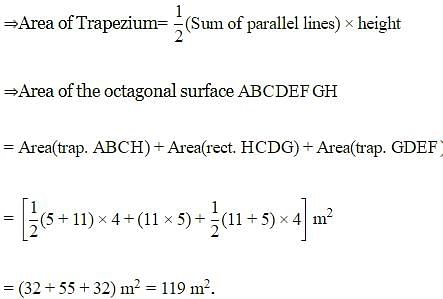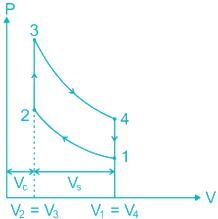HPCL Mechanical Engineer Mock Test - 10 - Mechanical Engineering MCQ
30 Questions MCQ Test HPCL Mechanical Engineer Mock Test Series 2024 - HPCL Mechanical Engineer Mock Test - 10
Directions: In the following question, a sentence is given with a blank. You have to fill the blank with one of the words given as options in order to make the sentence contextually and grammatically correct.
Human monkey pox was first identified in 1970 and named after the disease caused by the virus was _______________ in captive monkeys more than a decade before.
The average of 31 numbers is 57. The average of the first 10 numbers is 50 and that of the last 20 numbers is 61. What is the 11th number?
| 1 Crore+ students have signed up on EduRev. Have you? Download the App |
Top surface of a raised platform is in the shape of regular octagon as shown in the figure. Find the area of the octagonal surface.


If the side of the cube is 2 m, then the surface area of the cube is
The average number of visitors in a museum on each Sunday is 420 and the average number of visitors in the museum on any other day is 210. What is the average number of per day visitors in the whole month of April, which starts on Saturday?
What is the area of the largest circle that can be made inside a rectangle with 50 meters length and 42 meters breadth?
If a = 1/ (3-2√2) & b = 1/ ( 3+2√2) then the value of a2 +b2 is :-
Directions to Solve
In each word of the following questions consists of pair of words bearing a relationship among these, from amongst the alternatives, pick up the pair that best illustrate a similar relationship.
Question -
Silence : Noise
If the following numbers are written in ascending order then what will be the middle digit of the middle term?
815, 686, 795, 835, 765, 822, 719
Directions to Solve
Each of the following questions has a group. Find out which one of the given alternatives will be another member of the group or of that class.
Question -
Carpenter, Plumber, Electrician
If a Paper (Transparent Sheet ) is folded in a manner and a design or pattern is drawn. When unfolded this paper appears as given below in the answer figure. Choose the correct answer figure given below.
How will it look like when a transparent paper with given figure is folded on the dotted line as shown?
Question Figure

Answer Figure

In a Die-cutting operation, punching several holes in a sheet is called
In case of power failure, a battery is used to light a bulb, run a fan, and heat an electric iron (each of 100 W rating) for 10 minutes. In this process, the work done and heat supplied by the battery is given by :
Which of the following processes is the wire drawing process?
The standard sea level atmospheric pressure is equivalent to
The main alloying elements in high-speed steel are:
A 1 kg block is resting on a surface with coefficient of friction μ = 0.1. A force of 0.8 N isapplied to the block as shown in the figure. The friction force is
What is the heat required to raise the temperature of 1 kg mass of a substance by 1° C?
Hardness of steel depends upon the amount of
Which of the following devices is used to find the composition of exhaust gases from IC engines?
Hot coffee stored in a well insulated thermos flask is an example of
An Ideal gas at 27ºC is heated at constant pressure till the volume becomes three times. The temperature of the gas will then be
In an IC engine, combustion was found to proceed during the expansion stroke also. The reason could be:
In an Otto cycle, the heat addition and heat rejection take place at
A mass of 10 kg is resting on a rough table. The friction force required just to make the block move_____
A reservoir containing water has two orifices of the same size at depths of 4 m and 9 m below the free surface of the water. The ratio of discharges through these orifices is
The electrolyte in ECM is an aqueous solution of





























